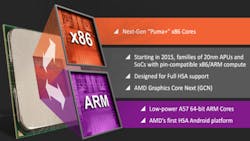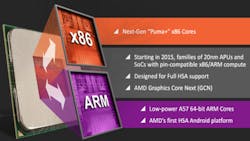AMD's Project SkyBridge Unifies x86 And 64-bit ARM
AMD's Project Skybridge starts to unify their x86 and ARM technologies with AMD's Ambidextrous Architecture. The solutions start with their APU SoCs and will flow to their SeaMicro superserver platforms. It uses a common interconnect fabric that essentially links the processor cores with peripherals and GPUs (Fig. 1).
This is a logical follow on to AMD's 64-bit ARM announcements (see “AMD ARMs 64-Bit Servers”) and the Heterogeneous System Architecture (HSA) that is found in their APU (Accelerated Processing Units) that contain CPU and GPU cores (see “Heterogeneous System Architecture Changes CPU/GPU Software”). AMD currently has ARM Cortex-A57 chips and that will be part of Project Skybridge but their future support will be based on the AMD K12 ARM core that will show up in 2016 (Fig. 2).
Related Articles
- AMD ARMs 64-Bit Servers
- Interview: Manju Hegde Talks About AMD's Heterogeneous System Architecture
- Heterogeneous System Architecture Changes CPU/GPU Software
- Unified Heterogeneous Computing Arrives
- What's The Difference Between AMD's Mantle and Media SDK
The first fruits of Project Skybridge will be pin compatible, 20-nm chips that sport Pum+ x86 cores or ARM Cortex-A57 cores along with AMD's GPU supporting HSA. Most users will not be swapping chips around but the approach will be very useful to vendors looking to provide flexible solutions while minimizing the number of motherboards they have to support. This will also be useful for AMD's SeaMicro platforms in the future what already support x86 and ARM solutions at the system level using boards specific to each type of core.
One reason AMD is taking this approach is to take advantage of high growth areas like the use of the ARM Cortex-A57 in servers. This is still a young market and AMD will have a good bit of competition. Whereas there is only one major x86 alternative, Intel, there are many sporting Cortex-A57 platforms. On the plus side, AMD is well established with its x86 solutions in the embedded, desktop and server markets. AMD also expects to take these chips into semicustom environments as well.
AMD is using a common on-chip fabric to link peripherals with the CPUs and GPUs. This provides the HSA support. HSA and the common fabric greatly simplifies system software development since it is incorporates so many common hardware components.
In a sense, this is parallel to the approach that many microcontroller companies have taken when they have different CPU architectures to contend with. The first step is to provide a common programming and tool solution. The second step is to integrate the peripherals and pin-compatiblity. Some companies eventually migrate to a single processor architecture but this cannot be done quickly or easily.
AMD is unlikely to fold their x86 platforms. They still provide higher performance than ARM solutions at this point but the ARM solutions will now compete on an even footing with their x86 counterparts allowing developers to chose the level of performance and power requirements.
The approach has some interesting implications for embedded developers that often had to chose from a plethora of x86 motherboards to a confusing array of ARM-based solutions that often did not play well with established peripheral I/O boards. Project Skybridge potentially makes those x86 solutions into ARM-based solutions.
AMD is also ignoring ARM arenas where they do not already have a presence such as the smartphone market. There are well established players in that space that already have 64-bit ARM chips on target. That still leaves a lot of room for some interesting competition.
About the Author
William Wong Blog
Senior Content Director
Bill's latest articles are listed on this author page, William G. Wong.
Bill Wong covers Digital, Embedded, Systems and Software topics at Electronic Design. He writes a number of columns, including Lab Bench and alt.embedded, plus Bill's Workbench hands-on column. Bill is a Georgia Tech alumni with a B.S in Electrical Engineering and a master's degree in computer science for Rutgers, The State University of New Jersey.
He has written a dozen books and was the first Director of PC Labs at PC Magazine. He has worked in the computer and publication industry for almost 40 years and has been with Electronic Design since 2000. He helps run the Mercer Science and Engineering Fair in Mercer County, NJ.
- Check out more articles by Bill Wong on Electronic Design
- Bill Wong on Facebook
- @AltEmbedded on Twitter


